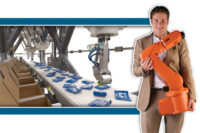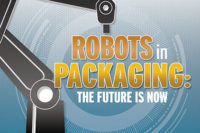Cover Story: Automate 2013
The evolution of robots in packaging
A look at the imminent growth in the use of automation that’s lending packagers a helping arm.

John Kowal, market development manager, B&R Industrial Automation Corp.

Ken McLaughlin, director, automation systems at JMP Engineering

Doug Taylor, principal engineer at Concept Systems, Inc.



The Robotic Industries Association (RIA) recently released data about the North American robotic industry, revealing that sales are up and proving that robots are here to stay, aiding in the efficiency and speed of the food and beverage packaging industry. North American-based robotics companies are in the midst of another strong year, with new orders up 20%, according to the new statistics.
A total of 16,363 robots valued at $1.1 billion were ordered in the first nine months of this year by companies in North America, an increase of 20% in units and 29% in dollars over the same period in 2011. Including numbers from outside North America, the totals are 18,844 robots valued at $1.25 billion.
RIA estimates that some 225,000 robots are now at use in factories in the United States, placing the U.S. second only to Japan in robot use. “Many observers believe that only about 10% of the U.S. companies that could benefit from robots have installed any so far,” says Jeff Burnstein, president of Robotic Industries Association, “and among those that have the most to gain from robots are small and medium sized companies.”
Robotics today, tomorrow and beyond
According to Burnstein, “Food packaging has become a proven robotic solution with a great track record of success. That’s why we see more and more applications of robots for food packaging applications. I believe the future holds even more growth in this market segment, especially with the improvements in gripper technology that allow robots to grasp and package a wider range of products.”
I reached out to The Control System Integrators Association (www.controlsys.org), a global non-profit professional association for control system integration companies that advances system integration for the success of members and their clients. From there I got in contact with two members and one partner member who shared outlooks on the robotic industry and where it’s headed.
Food and Beverage Packaging: How has robotics evolved for food packaging?
John Kowal: For primary food handling and packaging operations with food contact, there are more stainless steel and moisture sealed robotic mechanics for use in washdown environments. Vision guidance, checkweighing, labeling and inspection systems, along with gripper systems and end of arm tooling, have been developed to automate the portion packing of products and minimize product giveaway. In secondary and end-of-line packaging, robotics have found increasing use in cartoning, tray loading, case packing and palletizing applications. One trend that’s played out over the past decade is the use of powerful, standards-based machine controllers with mechanics-only sourced from either robot makers or designed by the machine builder itself, and integrated into the machine design. The idea is to reduce the number and footprint of control platforms and communications interfaces through use of a single unified control platform for all machine operations – including robotic kinematics, motion, logic, vision processing, integrated safety, condition and energy monitoring, human-machine interface and data acquisition.
Ken McLaughlin: Often, our clients in the food and beverage industry have never had a robot in their plant before, and are now looking for cost-effective ways to improve productivity, reduce costs and safety. Robotic automation is a great way to accomplish this. The biggest factor in the evolution of robotics for food and beverage has been meeting the rigorous sanitary and speed requirements. Often times, systems handling raw food need to be designed to meet USDA approval or American Meat Institute (AMI) recommendations. There are now robots available on the market that meet these requirements. Regarding speed, there are now high-speed five and six-axis traditional serial link robots available. Also, there is a plethora of Delta robots on the market that are easily capable of over 100 picks per minute.
Doug Taylor: One of the biggest evolutions of robotics in the food packaging industry is a result of the evolution of other technologies, specifically in the processing capabilities in visions and laser scanning technology. These imaging technologies can process more information at faster speeds. The result is higher resolution images which are processed with more advanced algorithms, ultimately leading to higher accuracy delivered at the speeds required for deployment in the manufacturing environment. These advancements are leading to the ability to deploy robots in applications beyond simple pick and place or path following. Quality robotic movement has been around for more than a decade, but only recently has higher quality 3D vision systems become economically feasible for food manufacturing processes. With more advanced 3D vision systems, robots are now able to compete for more food production and packaging jobs than they were in the past. This is why we are focusing our efforts on researching and developing the emerging 3D sensors into production quality vision systems that will complement the modern robot arm’s capabilities. When the vision system and the robot share the same level of total system accuracy, the robot solution will be consistently as good as the most experienced operator, especially in applications where a high degree of accuracy at a very high speed is an important benchmark of performance.
FBP: Do you predict that more robots will be used in the future of food packaging?
Kowal: Any time that a process can be automated it becomes more cost effective. Likewise, any time you can automate tasks that are tedious, repetitious and difficult to adapt to a more ergonomic solution, automation helps promote the health and safety of operations. Robotic automation lends itself to tasks that require flexibility in terms of variable product geometry, frequent changeovers and multiple pack patterns.
McLaughlin: Absolutely. We do most of our work in food and beverage, consumer packaging and oil and gas. We view those as the markets where clients are trying to reduce labor costs, improve throughput, and improve health and safety by eliminating repetitive tasks.
Fast, reliable and consistent
Robots are constantly evolving and improving for use in the food and beverage packaging sector. While people are inconsistent with operations, robots are very consistent, fast and reliable, making them a smart choice for food and beverage packaging, both today and tomorrow.
Looking for a reprint of this article?
From high-res PDFs to custom plaques, order your copy today!










